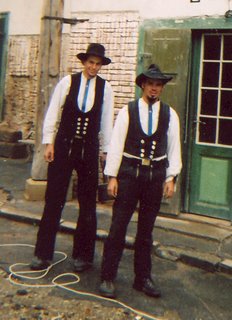 Sibiu, Romania. I was uncomfortable taking pictures of Roma girls and women, or interrupting family groups, but they were easily seen, in doorways, with companions in the street, as couples, as families at the bus or anywhere. Brightly colored clothing, long full skirts, beautiful jewelry(for the well-to-do) -distinctive.
Sibiu, Romania. I was uncomfortable taking pictures of Roma girls and women, or interrupting family groups, but they were easily seen, in doorways, with companions in the street, as couples, as families at the bus or anywhere. Brightly colored clothing, long full skirts, beautiful jewelry(for the well-to-do) -distinctive.These men may not be Roma, but instead traveling merchants from an old tradition that may have begun in the age of the Templars - see Romania Road Ways.
We did see Roma in casual, traditional and formal dress, for some occasion. And families. Very visible.
There are wide misunderstandings about Roma customs, and their history has been extremely difficult, including (according to this site) 500 years of enslavement in Romania. See this government site on the Roma - use only the dot org if the rest is not helpful. Sometimes the sites are so big that you may want assurance that you got to the right place. See www.media-diversity.org/articles_publications/A%20Problem%20Brewing%20Media%20Coverage%20of%20Roma%20in%20Romania. Roma were also subject to the mass exterminations of the holocaust. See, e.g., www.romnews.com/4_6. on the genocide issue. Roma survived and are a growing population, and remain all over Europe. In Slovenia as other places, however, the tensions remain. See Slovenia Road Ways There, the family was forced out, and has not been allowed to return.+
Roma history overall: See www.geocities.com/~patrin/timeline.
Basques: apparently, the cheek samples for DNA link this Spanish group to Celts. And, the Basques were great navigators. See Spain Road Ways. The cheek DNA testing is fascinating - I just saw an account on the History Channel, I think it was, that found a match between a young girl in the mountains of Mongolia, with reddish hair and fair skin, and a burial site of a culture of warrior women in, I believe it was, Macedonia. DNA followed the migration of the group to Mongolia. Even the patterns on the yurt, and clothing and walls in Mongolia were close to those on fabrics in the burial site.
The Vlachs are an ancient sheep-herding, nomadic people found in Romania and Greece, and probably elsewhere. See Greece Road Ways; and Romania Road Ways.
No comments:
Post a Comment